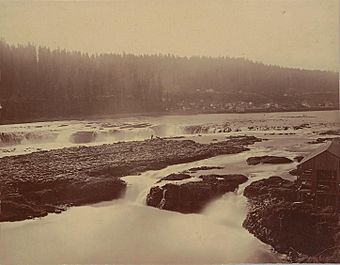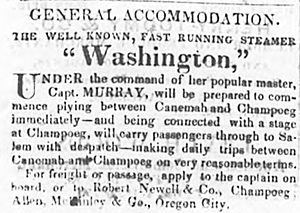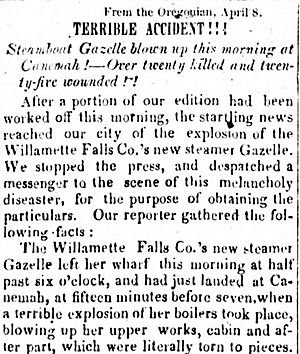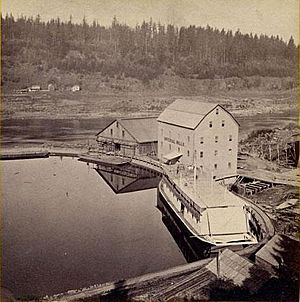Canemah, Oregon facts for kids
Quick facts for kids |
|
|
Canemah Historic District
|
|

Willamette Falls looking south, with Canemah, Oregon, in background on left, 1867
|
|
| Lua error in Module:Location_map at line 420: attempt to index field 'wikibase' (a nil value). | |
| Location | Roughly bounded by Willamette River, 5th Ave., Marshall and Paquet Sts., Oregon City, Oregon |
|---|---|
| Area | 63.7 acres (25.8 ha) |
| Built | 1928 |
| Architectural style | Classical Revival, Bungalow/craftsman, Gothic Revival |
| NRHP reference No. | 78002279 |
| Added to NRHP | October 11, 1978 |
Canemah was an important early settlement in Oregon, a state in the United States. It was located right next to the Willamette Falls on the Willamette River. In 1928, Canemah became part of Oregon City. Today, the area is known as the Canemah Historic District. It is a special place that helps us remember the past.
Contents
Where Was Canemah?
The Canemah area is on the east side of the Willamette River. Back then, Oregon City was a separate town. It was located below the Willamette Falls, while Canemah was above them. A simple path, later an ox track, connected the two towns. This connection was very important for travel and trade.
Early Days and Native Americans
Long before settlers arrived, Native Americans lived in Oregon. The Calapooya tribe considered this area their home. They used canoes to travel up and down the river, especially around the waterfall. Canemah was a key spot because it was the southern point where people had to cross the waterfall.
The name "Canemah" actually means "the canoe place." It was a very valuable area. Native American groups sometimes disagreed about who would control it. This was because whoever controlled Canemah could charge a fee to anyone who wanted to cross the waterfall in their canoe.
Pioneers Arrive
The first white settler in Canemah was a man named Absalom F. Hedges. He arrived in Oregon City in 1844. He found that all the good land was already taken. So, he traveled south to Canemah. There, he claimed land near the canoe landing spot.
At this time, Native Americans still did most of the river travel above the falls using canoes. But flat boats, called bateaux, were also starting to appear. Farmers in the Willamette Valley brought their crops to Canemah by boat or canoe. From Canemah, goods were loaded onto ox-carts. These carts carried them around the falls to Oregon City. New settlers and their belongings were also hauled back to Canemah from Oregon City by these same ox-carts.
The Start of Steamboat Travel
By 1849, Absalom Hedges had started a tannery, which made leather. He also planned out a townsite in Canemah, which he called "Falls City." He and his brother-in-law, William Barrow, opened a sawmill and a store. However, the name "Falls City" never really stuck, and people kept calling the place "Canemah."
As more boats traveled the river, Hedges and some partners decided to build a steamboat. This boat would travel on the Willamette River above the falls. Hedges collected a lot of gold and traveled back east to buy the special machinery for the boat. He bought two engines. These engines were shipped all the way around Cape Horn to Oregon. Hedges and his partners returned overland, a long journey.
Steamboats on the Willamette River

When Hedges and his group returned to Oregon, three steamboats were already working on the upper Willamette River. These were the Hoosier, Washington, and Multnomah. In June 1851, the small Hoosier was making three trips a week. It went from Canemah up the Yamhill River to Dayton. The much larger Multnomah was put together at Canemah in the spring of 1851. Its parts were made in the east. It had its first test run in August 1851.
Even with this competition, Hedges and his company started building their new steamboat. They named it Canemah. It was launched in late September 1851 and began service soon after. Around this time, a new ox road was built along the river. It was blasted through the basalt cliffs that separated Canemah from Oregon City. Wagons traveled on this road all day and night. At night, torches lit the way.
Canemah was a very important place in the 1850s. Many more stores and homes were built. Nine or ten more steamboats were also built there, in addition to the Multnomah and Canemah. One famous event during this time was the explosion of the new steamboat Gazelle on April 8, 1854. Other steamboats built at Canemah in the 1850s included the Yamhill (1851), Shoalwater (1852), Wallamet (1853), Enterprise (1855), James Clinton (1856), Elk, Surprise (1857), Onward, and Moose.
Rebuilding After a Big Flood
Canemah was built very close to the river's level. Because of this, it was almost completely destroyed by a huge flood in December 1861, known as the Great Flood of 1862. After the flood, the docks and some buildings were rebuilt. People thought the town would become successful again. More steamboats were built. A special portage railway was also constructed along the east bank. This railway replaced the slow ox carts for moving goods around the falls.
The People's Transportation Company was formed. This company built a better boat basin above the falls. They also cleared a canal below the falls. This made the distance for carrying goods much shorter. New steamboats were built above the falls to serve customers further upriver. These included a second Yamhill (1860), Unio (1861), a second Enterprise (1863), Reliance (1865), Active (1865), Fannie Patton (1865), Echo (1865), Albany (1868), Success, and Dayton (1868).
Why Canemah's Importance Declined
In 1870, the Oregon State Legislature decided to build locks on the west side of the falls. Locks are like water elevators that allow boats to move between different water levels. By 1873, these locks were finished. Now, steamboats could travel directly from Portland all the way to Corvallis without having to unload and reload goods.
Towns like Canemah, which were important because of the portage (carrying goods around the falls), started to lose their importance. During the 1870s, three or four more steamboats were built at Canemah. These were the last ones built above the falls: the Shoo-Fly, Alice, McMinnville (1877), and the smaller Carrie Norton (1878). By 1892, the name Canemah was almost forgotten. The area became just another part of Oregon City. Today, Canemah is recognized on the National Register of Historic Places as a historic district. This means it's a special place with a rich history that is protected.




